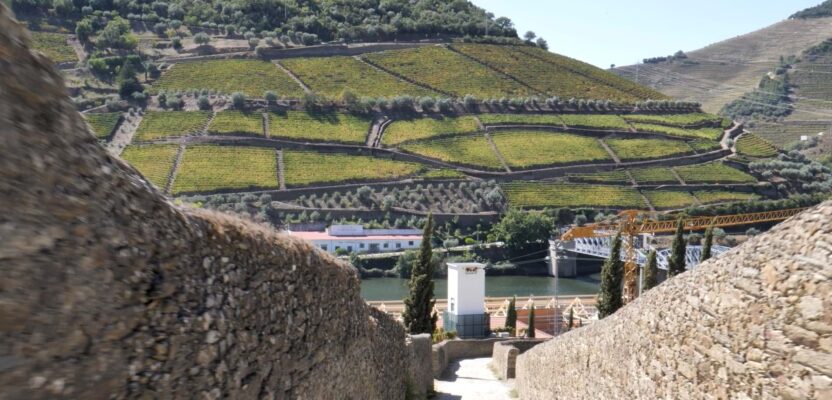One of the best vineyards in the world receives care and correction guided by smart maps
By Matt Ball
Photography courtesy of The Symington Family Estates
The conditions that propelled the 2011 Dow’s Vintage Port to be named Wine Spectator’s 2014 Wine of the Year are well documented but difficult to duplicate. That’s why the phrase “it was a good year” resonates so strongly with winemakers and wine enthusiasts everywhere.
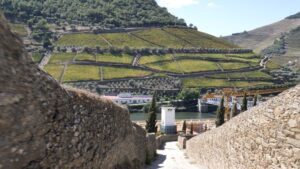
The steep Douro River Valley contains all 27 port wineries owned by the Symington family, which is now managed by its fifth generation.
According to Pedro Leal da Costa, head of viticulture at Symington Family Estates, the rain came at the right time, the temperature and humidity fluctuations were perfect, and the ripening pace was ideal.
Symington Family Estates produces some of the top port wines of the world, in the Douro River Valley in Portugal, for brands that include Graham’s, Dow’s, Warre’s, Cockburn’s, Quinta do Vesuvio, and Prats + Symington. While the company can’t control the weather—especially now with the more extreme conditions brought on by climate change—it can refine its processes.
“We’re always looking for the top science in agriculture to produce a better product,” Leal da Costa said.
Symington’s winemakers record the changing conditions and the corresponding health of the grapes and soil by using an enterprise geographic information system (GIS). It allows them to track the variables for each of the family’s 27 estates.
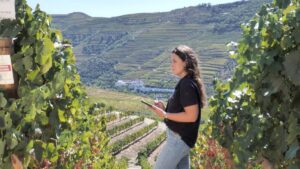
Images and data are collected for each vine and grape bunch to time treatments and harvest.
The health and ripeness of every bunch of 53 different varieties of grapes of the Grape Library project managed by the R&D team, along with the maturation network, get tracked in GIS. The data is used to create maps that guide field crews across each winery.
GIS also helps determine timing, which Leal da Costa calls its superpower.
“We have to wait for the grapes, to know when to stop, when to advance, and when to harvest,” continued Leal da Costa.
Quality Hinges on the Harvest
Leal da Costa often sends pickers to the same vines many times to ensure that only the ripest grapes are harvested. Grapes are monitored, sampled, tasted, and chemically analyzed to determine the right timing.
“We have a map of the phenological stages of the grapes,” Leal da Costa said, referring to the seasonal biological events that are influenced by climatic factors. The mapping includes close-up photos of grape clusters and high-resolution aerial imagery for both the micro scale of each vine and the macro scale of each winery. Analysis of the samples and images of the size and color of the grapes helps determine where the best quality grapes are at that moment.
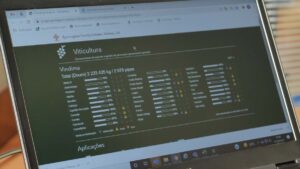
The app includes dashboards that display progress of harvest and other metrics.
“Harvest time is the most important time of the year for our use of GIS,” Leal da Costa said. “We look at the results from all parcels in real time, recording all the grapes as they are gathered.”
Every Monday throughout the year, Leal da Costa examines the data with Fernando Alves, head of Symington’s research and development viticulture team, and all team technicians. They look across the operation at the timing and amount of applied fertilizer and pest treatments, the weather, and the work being done.
The data is visualized and pored over to map problems and solutions and adjust for efficiency and profit. If results indicate that a specific treatment worked well, it gets repeated across vineyards.
The Foundations of Sustainability
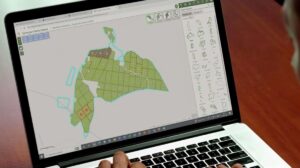
A map of each of the Symington family’s 27 estates displays detailed data.
The Symington family has a long-term view of investments in its vineyards. Every plant matures for six years before it reaches full production. That’s a long view for most agricultural operations, but not a long time for the family business, which extends back five generations.
“It’s a very slow business,” Leal da Costa said. “This is not for people who want to make money quickly.”
Symington prides itself on constant improvements and staying at the forefront of the port and winery business. A data-driven approach has been applied for decades to monitor each estate as well as to keep track of grape maturity.
Through GIS, viticulturists manage the health of the soil, ensuring its fertility for future crops. GIS also helps them to implement strategies aimed at mitigating the impacts of climate change on their vineyards.
Soil health is of particular importance in this rocky region.
“We have to improve the quality of soil, breaking down our soft stone soil to construct new soil that’s better and deeper,” Leal da Costa said.
The attention to soil is another long process of care and correction. The rocky schist soils of the Douro River Valley have low levels of organic matter and are too acidic. Using GIS to analyze the different parameters affecting soils, vintners can make informed decisions on how to improve and maintain the quality.
“We have to introduce calcium to up the pH of soils closer to 6.3 when they naturally are at 4.8. It’s not easy, but it works,” he said.
Decades of Data-Driven Improvements
“You can make good wine or bad wine with good grapes,” Leal da Costa likes to say, “but you can’t make good wine with bad grapes.”
His background in soil fertility and plant nutrition includes work with a lab located in Fort Wayne, Indiana, that prides itself on having scientists who don’t mind getting dirty. He would send soil samples from Spain and Portugal and get results that improved production quality.
“It was quite a revolution because we didn’t sell fertilizers, we sold ideas,” Leal da Costa said.

The viticulture team can access data from phones to check on grape conditions and quality readings.
In this work, he helped farmers growing grapes, olives, and other produce. His passion for viticulture, and the geographic approach, led him to Symington. There he has concentrated on improving the fertility of the soil with a focus on quality grapes rather than abundance.
“A big amount does not produce the best results,” Leal da Costa said. “You make the most money when you have perfect grapes, and you produce the best wine.”
To make the grapes better, detailed management plans are adapted to each location. Approaches differ for sites that are too humid or too dry, and for different soil profiles. The maps inform the field work.
“We know what to do in each place and more or less when,” Leal da Costa said. “We have all the information, and we know the results and where we are spending our time.”
Developing Research Wineries and a Library of Resilient Grape Varieties
With five generations of port making in Portugal, Symington Family Estates has a strong commitment to the uniqueness of the growing conditions and the grapes that make port wine.

A map of each of the Symington family’s 27 estates displays detailed data.
The company set aside a vineyard in 1997 for research to dive more deeply into the science and to experiment with planting and identifying the best varieties to use for each of its 27 vineyards. Since then, two more research sites have been planted at different altitudes to account for all of the conditions in the Douro River Valley.
The vineyards contain 53 grape varieties (29 red and 24 white), with careful attention paid to providing equal conditions for all grapes to conduct meaningful comparisons with the help of researchers from various universities. The aim is to understand how varieties tolerate heat and drought to safeguard and preserve Portuguese grape varieties from the pressures of climate change.
The data gathered from each vine is carefully mapped to conditions with an eye toward future conditions to make sure port wines continue.
“It’s not just for us,” Leal da Costa said. “It’s for the region.”
Adapting to the Location and Conditions
Maps aid the connection between viticulture, the cultivation of the grapes, and enology, the winemaking. The common language involves the micro terroir of each vineyard, which relates the influence of altitude, temperature, and proximity to the river in the taste of the grapes. The level of detail and precision of this knowledge improves the quality of the grapes and determines the right mix of grapes in each wine.
“We are always talking between the winery and the fields with maps,” Leal da Costa said. The maps go to field managers to show exactly where to harvest. Changes to the map inform everyone of the work ahead and keep them centered on quality.
Wine Spectator commended the 2011 Dow’s Vintage Port for its chocolate and spice flavors and its “almost endless finish.” All the workers at Symington can relate to the endless comment, since that’s how they approach the work—learning from the data to make constant improvements.
“I meet with Charles Symington every two days,” Leal da Costa said. “We can see where problems are, where we have advanced ripeness, and where we should slow down because we’re going too fast.”
GIS is a perfect fit for an organization that emphasizes quality over quantity. “We can do an excellent job using this microscopic viticulture in big areas,” Leal da Costa said.
Matt Ball is the editor of the Esri Blog and writes about innovative applications of geospatial technology. With nearly 30 years of reporting on GIS technology, he has chased future-forward user stories and watched as ideas, tools, and approaches have become common practice.

